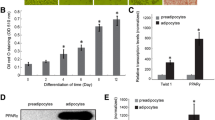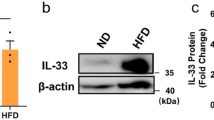Abstract
This study is to investigate the role of adenovirus 36 (Ad36) in regulating expression of peroxisome proliferator-activated receptor γ (PPARγ) and cell death-inducing DFFA-like effector c (CIDEC) in Ad36-induced adipocyte differentiation. Human adipose-derived mesenchymal stem cells (hAMSCs) were isolated and cultured, and then infected with Ad36. Ad36-induced adipocytes were identified using quantitative real-time PCR and Oil red O staining. The expression levels of PPARγ and CIDEC in Ad36-induced adipocytes were determined by quantitative real-time PCR and Western blot analysis. Glucose uptake and intracellular triglyceride content were also determined in these induced cells. Our results from the Oil red O staining showed that Ad36 induced the differentiation of hAMSCs into human adipocytes in vitro. Moreover, the medium glucose concentration was significantly decreased, while the intracellular triglyceride content was significantly increased, in the Ad36-induced adipocytes, compared with the control group. Furthermore, our results showed that, the mRNA and protein expression levels of PPARγ and CIDEC were significantly upregulated in Ad36-induced adipocytes, in a time-dependent manner. On the other hand, compared with the control group, the CIDEC expression was downregulated when the Ad36-induced adipocytes were treated with the PPARγ inhibitor, GW9662. Ad36 could upregulate the expression level of CIDEC through increasing PPARγ expression during the adipocyte differentiation process.







Similar content being viewed by others
References
Renehan AG, Tyson M, Egger M, Heller RF, Zwahlen M (2008) Body-mass index and incidence of cancer: a systematic review and meta-analysis of prospective observational studies. Lancet 371:569–578
Na HN, Hong YM, Ye MB, Park S, Kim IB, Nam JH (2014) Adenovirus 36 attenuates weight loss from exercise but improves glycemic control by increasing mitochondrial activity in the liver. PLoS ONE 9:1–19
Dhurandhar NV, Israel BA, Kolesar JM, Mayhew GF, Cook ME, Atkinson RL (2000) Increased adiposity in animals due to a human virus. Int J Obes Relat Metab Disord 24:989–996
Atkinson RL, Dhurandhar NV, Allison DB, Bowen RL, Israel BA, Albu JB, Augustus AS (2005) Human adenovirus-36 is associated with increased body weight and paradoxical reduction of serum lipids. Int J Obes 29:281–286
Berger PK, Pollock NK, Laing EM, Warden SJ, Hill Gallant KM, Hausman DB, Tripp RA, McCabe LD, McCabe GP, Weaver CM, Peacock M, Lewis RD (2014) Association of adenovirus 36 infection with adiposity and inflammatory-related markers in children. J Clin Endocrinol Metab 99:3240–3246
Pasarica M, Mashtalir N, McAllister EJ, Kilroy GE, Koska J, Permana P, de Courten B, Yu M, Ravussin E, Gimble JM, Dhurandhar NV (2008) Adipogenic human adenovirus Ad-36 induces commitment, differentiation, and lipid accumulation in human adipose-derived stem cells. Stem Cells 26:969–978
Jiao Y, Mao X, Chang X, Abudureyimu K, Zhang C, Lu J, Wang Y, Nuermaimaiti N, Aisa Y, Gong X, Guan Y (2014) Adenovirus36 infection expresses cellular APMI and Visfatin genes in overweight Uygur individuals. Diagn Pathol 9:83
Dubuisson O, Dhurandhar EJ, Krishnapuram R, Kirk-Ballard H, Gupta AK, Hegde V, Floyd E, Gimble JM, Dhurandhar NV (2011) PPARcindependent increase in glucose uptake and adiponectin abundance in fat cells. Endocrinology 152:3648–3660
Yeh WC, Cao Z, Classon M, McKnight SL (1995) Cascade regulation of terminal adipocyte differentiation by three members of the C/EBP family of leucine zipper proteins. Genes Dev 9:168–181
Wu Z, Rosen ED, Brun R, Hauser S, Adelmant G, Troy AE, McKeon C, Darlington GJ, Spiegelman BM (1999) Cross-regulation of C/EBP alpha and PPAR gamma controls the transcriptional pathway of adipogenesis and insulin sensitivity. Mol Cell 3:151–158
Wu C, Zhang Y, Sun Z, Li P (2008) Molecular evolution of Cide family proteins: novel domain formation in early vertebrates and the subsequent divergence. BMC Evol Biol 8:148–159
Borén J, Taskinen MR, Olofsson SO, Levin M (2013) Ectopic lipid storage and insulin resistance: a harmful relationship. J Intern Med 274:25–40
Saraf N, Sharma PK, Mondal SC, Garg VK, Singh AK (2012) Role of PPARg2 transcription factor in thiazolidinedione-induced insulin sensitization. J Pharm Pharmacol 64:161–171
Keller P, Petrie JT, De Rose P, Gerin I, Wright WS, Chiang SH, Nielsen AR, Fischer CP, Pedersen BK, MacDougald OA (2008) Fat-specific protein 27 regulates storage of triacylglycerol. J Biol Chem 283:14355–14365
Dominici M, Le Blanc K, Mueller I (2006) Minimal criteria for defining multipotent mesenchymal stromal cells. The International Society for Cellular Therapy position statement. Cytotherapy 8(4):315–317
Gortmaker SL, Swinburn BA, Levy D, Carter R, Mabry PL, Finegood DT, Huang T, Marsh T, Moodie ML (2011) Changing the future of obesity: science, policy, and action. Lancet 378:838–847
Park S, Kim J, Shin HJ, Hong YM, Sheen YH, Park HL, Jeon HJ, Ahn SY, Nam JH (2015) Tracking study about adenovirus 36 infection: increase of adiposity. J Microbiol Biotechnol 25:2169–2172
Hamm JK, el Jack AK, Pilch PF, Farmer SR (1999) Role of PPAR gamma in regulating adipocyte differentiation and insulin-responsive glucose uptake. Ann N Y Acad Sci 892:134–145
Kawada T (1998) Lipid metabolism related nuclear receptor—the structure, function, expression and classification of peroxisome proliferation-activated receptor (PPAR). Nihon Rinsho 56:1722–1728
Takeyama K, Kodera Y, Suzawa M, Kato S (2000) Peroxisome proliferator-activated receptor (PPAR)—structure, function, tissue distribution, gene expression. Nihon Rinsho 58:357–363
Fajas L, Fruchart JC, Auwerx J (1998) PPARγ3 mRNA: a distinct PPAR gamma mRNA subtype transcribed from an independent promoter. FEBS Lett 438:55–60
Elbrecht A, Chen Y, Cullinan CA, Hayes N, Leibowitz Md, Moller DE, Berger J (1996) Molecular cloning, expression and characterization of human peroxisome proliferator activated receptors gamma 1 and gamma 2. Biochem Biophys Res Commun 224:431–437
Ren D, Collingwood TN, Rebar EJ, Wolffe AP, Camp HS (2002) PPARγ knockdown by engineered transcription factors: exogenous PPARγ2 but not PPARγ1 reactivates adipogenesis. Genes Dev 16:27–32
Li JZ, Li P (2007) Cide proteins and the development of obesity. Novartis Found Symp 286:155–159
Almgren M, Atkinson RL, Hilding A, He J, Brismar K, Schalling M, Ostenson CG, Lavebratt C (2014) Human adenovirus-36 is uncommon in type 2 diabetes and is associated with increased insulin sensitivity in adults in Sweden. Ann Med 46:539–546
Acknowledgements
This study was supported by the National Natural Science Foundation of China (No. 81660154) and the College Students Innovation Experiment Program (CX2015002).
Author information
Authors and Affiliations
Corresponding authors
Ethics declarations
Conflict of interest
All authors declare no financial conflict of interest. All authors declare no non-financial conflict of interest.
Additional information
Yi Jiao and Yiliyasi Aisa contributed equally to this work.
Rights and permissions
About this article
Cite this article
Jiao, Y., Aisa, Y., Liang, X. et al. Regulation of PPARγ and CIDEC expression by adenovirus 36 in adipocyte differentiation. Mol Cell Biochem 428, 1–8 (2017). https://doi.org/10.1007/s11010-016-2912-x
Received:
Accepted:
Published:
Issue Date:
DOI: https://doi.org/10.1007/s11010-016-2912-x




